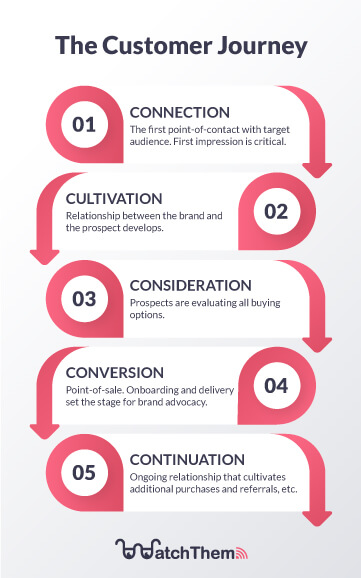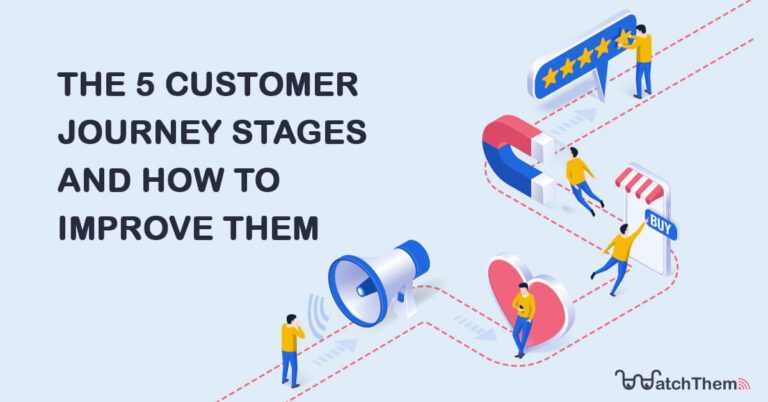Page Contents
The single most critical thing you can do to develop your company is to create an effective customer journey map. When done effectively, it will contain five customer journey stages. If your company already has developed and uses a customer journey map, you’re already aware of how important it is to understand how customers interact with your company.
However, simply determining these customer journey phases does not guarantee that it will meet expectations. There may be areas for improvement, untapped potential for better understanding your clients, or an opportunity to put that data into measurable actions.
Here in this article, we will provide you with some basic definitions, and after that, we’ll try to name and improve each of the customer journey stages. So, let’s get to it.
More articles on customer behavior and marketing strategies


Definition
Each customer sets out on a path to purchase a product. A customer will go through five distinctive phases from beginning to end. Each step will have its own set of challenges and obstacles that you will need to help your customer overcome. All five phases are part of what’s known as the “onboarding process.”
A first impression is something you never can remake throughout the customer experience. Onboarding takes care of that initial interaction and gives your potential client trust in both the companies they’re working with and the product they’re using.
But the story does not end there. At any step in the sales funnel, customers can exit. As a result, the end-to-end path you present to potential buyers can have a significant impact on the outcome of your relationship with your customers.
Planning
Before you start this process, make sure you know who your customer is. For more information, visit our previous post on persona mapping your customers. It’s critical that you create a persona, or several personas, for your target audience.
You can better create a proper journey process once you’ve worked out who your clients are and where they’re coming from. For example, a single user who is new to your software and runs their own business will not want to be presented with enterprise communications.
We’re all familiar with the concept of creating a marketing campaign. Onboarding is no exception. It’s all about coming up with a plan that’s similar to any other you’ve tried before.
You should be very clear about both your goal and your plan to achieve that goal.
Related Article: The Ultimate Guide to Customer Journey Management in 2022
The 5 Customer Journey Stages
The customer journey can be divided into several segments and Each stage shows a person’s current level of decision-making.
The number of phases in the customer journey varies depending on multiple factors, but as illustrated in the diagram below, the procedure is usually divided into five steps.


Each stage of the customer journey requires a strategy. This allows you to meet prospects’ needs at their current phase of the buying process. It will also assist you in making the most of every opportunity to convert customers. Let’s explore them and find out what they involve precisely.
Customer Journey Stage 1: Connection
This is the beginning of the customer journey, often known as “awareness.” Here, prospects learn about your company from a variety of sources. A few examples are social media, advertisements, and word-of-mouth.
The connection stage is the most important of the five. Why? You make your initial impression here, after all.
You only have a few seconds to make an excellent first impression, and you won’t get another chance. A strong brand gives your company a more professional appearance. It also boosts the perceived value of your products and services.
Customer Journey Stage 2: Cultivation
So, what happens if you start a conversation with a lead who isn’t quite ready to buy? You’ll stay in touch with them from the minute you connect until they buy (or decide not to).
You’ll need a customer experience that keeps people engaged through the whole process. This could be the most challenging part of creating the client’s journey. It’s not simple to keep people’s attention, especially in this age of two-second attention spans.
So what should you do about this matter? Just keep doing what is your company’s strength and maintain consistency in it. Here are some examples:
- Which kind of business promotion do your customers prefer?
- What skills do you have that you can use to advertise your company?
- How regularly are you willing to do it? Daily? Once a week, maybe?
Customer Journey Stage 3: Consideration
In the consideration stage, people are weighing their options.
The significance of this stage is frequently overlooked. During this stage, prospects are serious about purchasing your product or service. But they are still not sure and can easily buy from your rivals.
People in this stage need some right brand signals. These signals indicate which company is best suited to provide them with what they desire.
This is where a strong brand essence comes in handy. A brand strategy will assist you in determining the signals prospects seek and how to express them.
Customer Journey Stage 4: Conversion
Here’s when good things happen the lead finally becomes a customer at this step of the customer cycle. Now it’s up to you to follow through on the commitments you made before.
Getting five-star reviews requires staying “on brand” throughout the customer journey. And many of those delighted clients will become brand ambassadors, spreading the word about you to everyone they know. This is the best example of a free advertisement you could ask for.
Customer Journey Stage 5: Continuation
At this stage, your customers are continuing to buy from you more than once. They think you’re fantastic and want to spend the rest of their lives with you. Many of them have turned into brand evangelists by now.
Finding a new consumer is more difficult than reselling to an existing one. Maintain contact with your clients—without being intrusive, of course. Maintain your relevance so that you can continue to address their needs. This way, you have guaranteed your base sales for a long time.
How to Improve Customer Journey Stages
After all, now it’s time to provide you with a solution to improve these customer journey steps. There are some complicated procedures you can take for each step to make it better. However, we offer you a more straightforward way. You can use customer tracking software that is available in the market for this particular case. WatchThemLive analytics is one of them.
WTL services such as session replay and user tracking are exactly what you need in this case. Our user tracking service will let you know every tiny movement and behavior of your audiences on your website. Therefore, you will understand them better and, for example, make better persona maps. All of these services are entirely free and easy to use. So, if you feel that you need some help with improving your customer journey stages, sign up now.
Conclusion
The customer journey assists you in sending the appropriate message to the right individuals at the right time. Just keep in mind, In all stages of the consumer journey, a strong brand increases your value. So, make your brand stand out.

